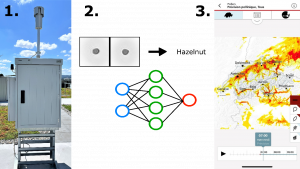Automatic bioaerosol identification in real-time
The project work focuses on bioaerosol identification in real-time based on the Swiss Automatic Pollen monitoring network of MeteoSwiss. MeteoSwiss co-developed and installed, from 2019 to 2022, an automatic pollen monitoring network in order to provide concentrations of allergenic pollen to the public. These data are crucial for the prevention and treatment of pollen allergies, which affect about 20% of the Swiss population. The network is composed of airflow cytometers, called Swisens Poleno Jupiter, that measure each particle individually. Their functioning is relatively straightforward; as particles fly through the instrument, they are triggered by two lasers to assess their speed, then holographic images are taken by two cameras (at 90° one from another) and finally single particles are successively excited by three different laser sources and their emission spectra is measured. The obtained holographic images and fluorescence spectra are then used as inputs for artificial neural networks to identify each particle.
The research focuses on improving and extending the potential of the network through better automatic identification. Thus, we mainly focus on two aspects: the artificial intelligence methods themselves, and the data needed to train these algorithms. The actual system developed for the recognition of pollen grains uses only the holographic images for identification and only targets the most important groups in terms of allergy. Our goal is, through the combination of holographic and fluorescence data, to be able to identify automatically and more precisely (species level) pollen grains but also to extend that capacity to new particle classes, notably fungal spores. This work is part of two coordination projects that aim to monitor bioaerosol at the European scale (AutoPollen and SYLVA).

From outdoor measurement (1.), through data analysis (2.) until the final product, pollen maps and predictions (3.). This research focuses on step 2., convert environmental data into measured bioaerosol concentrations.
Researcher: Sophie Erb